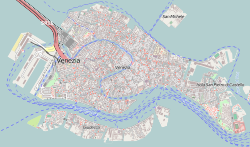| Church of San Biagio | |
|---|---|
 | |
| Religion | |
| Affiliation | Roman Catholic |
| Province | Venice |
| Location | |
| Location | Venice, Italy |
| Coordinates | 45°25′57″N12°21′00″E / 45.4325°N 12.3501°E |
| Architecture | |
| Architect | Filippo Rossi |
| Type | Church |
| Style | Baroque |
| Completed | 1752 |
San Biagio is a church dedicated to Saint Blaise, in the sestiere of Castello in Venice, northern Italy.

